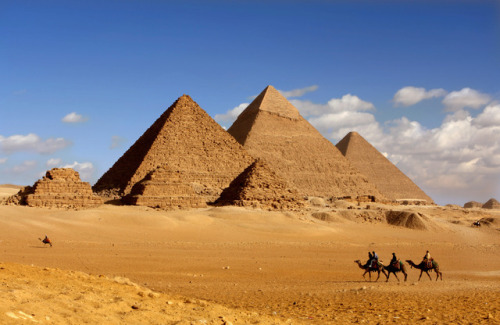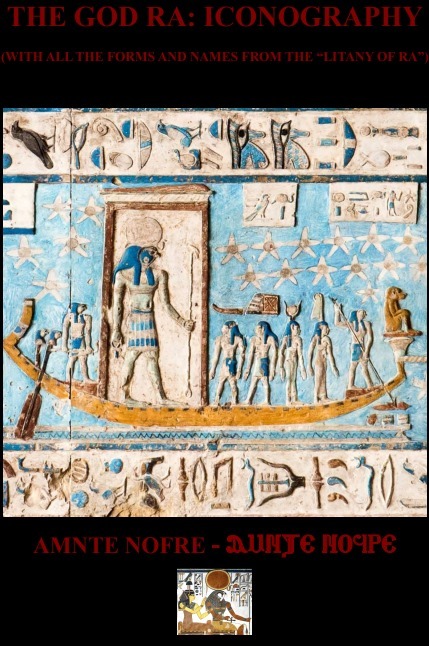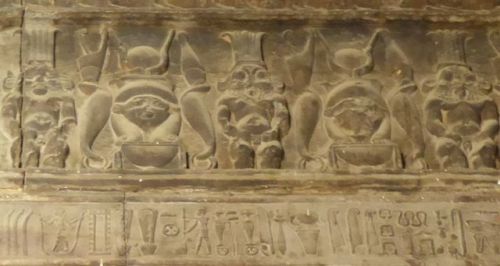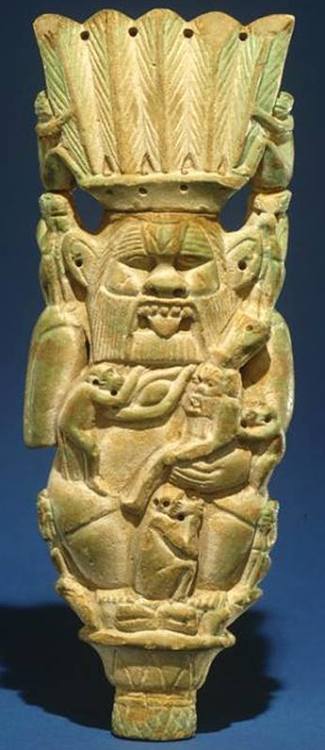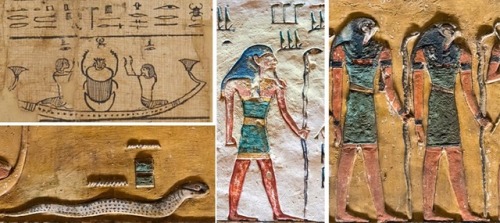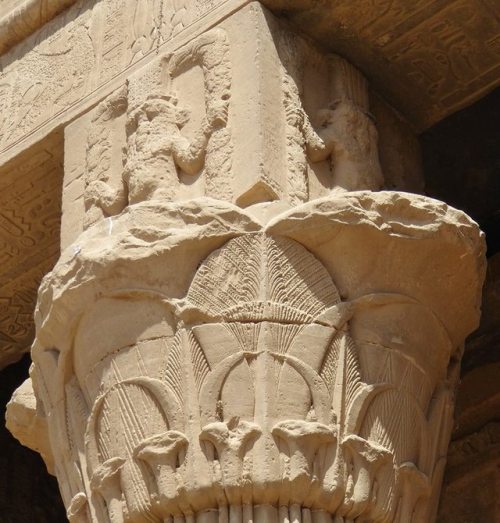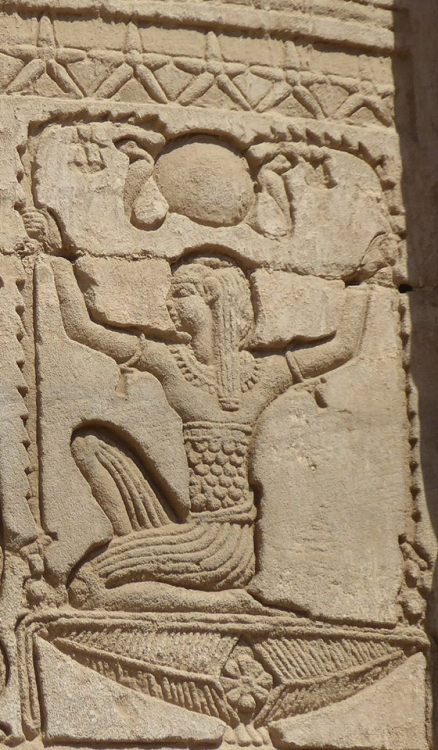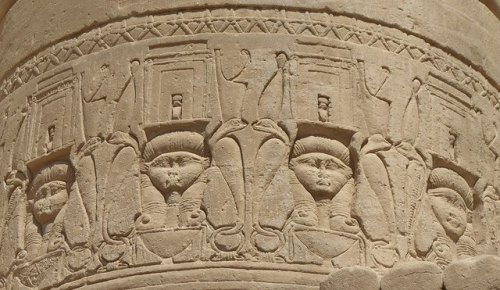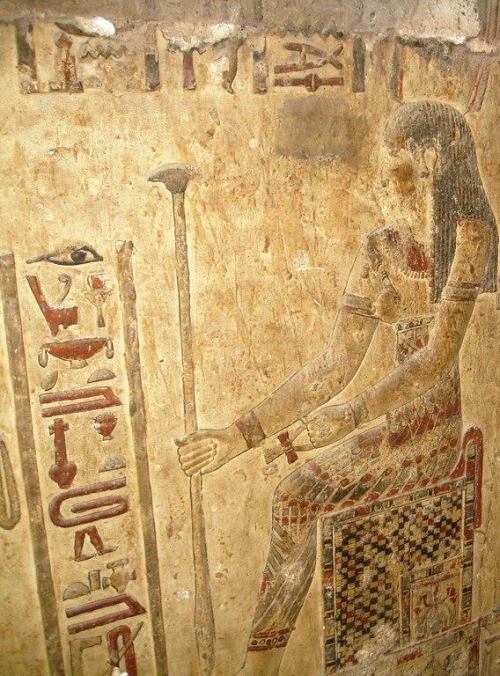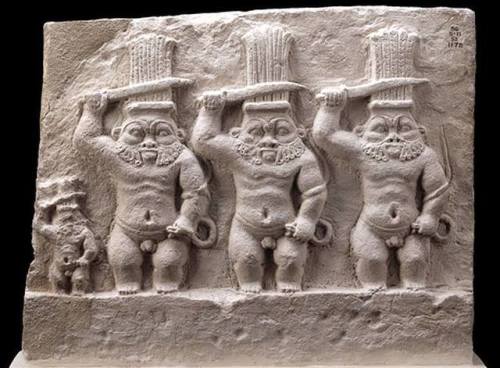#ancientegypt
Temple of the God Horus at Behdet (Edfu), west side of the Pylon’s Entrance-Gate: statue of Horus in His form of sacred falcon (one of the two statues standing on each side of the Entrance-Gate) standing protectively over the King (identified as King Nectanebo II)
Post link
detail from the “House of Birth” (the Mammisi) of the Sanctuary of the God Horus at Behdet (Edfu):
the Goddess Hathor suckling Harsomtou the Child
Post link
the God Horus, falcon-headed, wearing the Double Crown, and represented upon a base with two sacred scarab, and the Goddess Meret raising Her hands in adoration.
Detail from a column of the “House of Birth” (the Mammisi) of the Sanctuary of the Goddess Hathor at Nitentóre (Dendera)
Post link
the background wall of the Inner Shrine of the “House of Birth” (the Mammisi) of the Sanctuary of the Goddess Hathor at Nitentóre (Dendera)
Post link
THE GOD RA: ICONOGRAPHY
here’s my study dedicated to the iconography of the God Ra, freely available on-line, where you will find an introduction to the iconography of Ra together with more than 100 images (with a full description) of all His various forms. Moreover, in the last part you will find all the images and the names of the forms of Ra from the “Litany of Ra” (Great and Little Litany), together with all the invocations.
https://www.academia.edu/15862606/The_God_Ra_Iconography
Contents:
Introduction:
-Ra as a falcon-headed man
-Anthropomorphic form of Ra
-Zoomorphic and combined forms of Ra
-The Sun with the forms of Ra
Iconographic index:
I part: Ra as a falcon-headed man
II part: Ra in anthropomorphic form
-Ra in His form of Divine Child
III part: Ra in His form of sacred falcon
-Ra as a human-headed falcon
-Ra as a ram-headed falcon
IV part: Ra in His form of sacred cat
-Ra as a cat-headed man
V part: Ra as a lion-headed man
-Ra in His form of hieracosphinx
VI part: Ra in His sacred forms of calf and bull
VII part: Ra in His forms of sacred baboon and baboon-headed man
VIII part: Ra in His form of sacred serpent
IX part: Ra as a crocodile-headed man
-Ra in His form of sacred crocodile
X part: Ra as a ram-headed man
-the “flesh of Ra” in the “Books of the Netherworld”
-Ra in His form of four-faced ram
XI part: the Sun with the forms of Ra
XII part: “The Litany of Ra”:
-introduction
-the ‘Prologue’ of the “Great Litany”
-the forms of Ra in the “Great Litany”
-the forms of Ra in the “Little Litany”
Post link
alternating images of the God Bes and Hathor-heads standing on the symbol for “gold” and flanked by the Two Goddesses Nekhbet and Outo in Their form of Uraei (Nekhbet wearing the White Crown and Outo with the Red Crown).
“House of Birth” (the Mammisi) of the Sanctuary of the Goddess Hathor at Nitentóre (Dendera),
detail from the frieze of the Inner Vestibule, west wall
Post link
faience plaque of the God Bes sitting on a lotus flower, and surrounded by monkeys; in His left arm He cradles an infant Bes figure.
ca. 1075-656 BCE. Now in the University of Pennsylvania Museum…
Post link
Egyptian Religious Calendar
Today 21 June 2019 - XIX day of Khenty-Khety, the tenth month of the Egyptian Lunar Calendar (in the CDXX Great Year of Ra according to the Egyptian Civil Calendar).
Summer Solstice: Glorious and Blessed Summer Solstice to everyone!!!
(quotes from
“Egyptian Religious Calendar: CDXIX-CDXX Great Year of Ra (2019CE)”. The book is available on amazon: http://a.co/d/clZRHoW
By subscribing to “AMENTE NOFRE-MEMBERSHIP COMMUNITY” you will get a complete access to the daily posts of the Ancient Egyptian Religious Calendar and to our online courses in Egyptology, here’s the link with all the infos: https://www.patreon.com/amentenofre)
Religious Prescriptions:
Favorable day
“Do not go out at midday.” [c.c.]
Religious Festivities:
The XIX day of the lunar month is sacred to Imseti. It is the “Feast of Hearing His Words” and Iun-mut-ef is the God of the Feast.
- Offerings by the chief of the singers, the performer of the ritual of the dismembering of Seth (thirty-day festivity, XXV day)
[T. Behdet, c. Hathor]
- Feast of the Conception of Horus son of Isis and Osiris (…) (twenty-seven days, XXII day)
[T. Behdet, c. Hathor]
image: the Leo Zodiac sign represented upon a huge serpent;
detail from the astronomical ceiling (westernmost strip) of the Outer Hypostyle Hall of the Temple of the Goddess Hathor at Nitentóre (Dendera)
Post link
the twelfth and thirteenth lesson of the Egyptology course “BOOK OF THE AMDUAT, DEITIES AND SCENES: FIRST DIVISION”on“Amente Nofre-membership community” are on-line.
Here’s a preview (first division of the Amduat, middle register, lower part), from left to right:
the sacred barque of Khepry represented in His form of sacred scarab and flanked by two images of Osiris both kneeling and making adorations;
the Serpent-God Npn, “the Pointed-one”;
Smwy, “He of the plants”, holding a serpent-staff;
Mdwy, “He of the staff”, and Ḏȝwty, “He of the garment”, both falcon-headed and holding a serpent-staff.
Images from the funerary papyrus of the priest Nesmin, from the “House of Eternity” of King Sethi I (KV17), and from the “House of Eternity” of King Ramses V and King Ramses VI (KV9).
Become a patron of “Amente Nofre-membership community” for as little as $3/month or $5/month and you will participate in our online courses in Egyptology (and moreover you will get a complete access to the daily posts of the Ancient Egyptian Religious Calendar), see here:
https://www.patreon.com/amentenofre
Post link
the God Horus in His form of sacred falcon spreading His wings in protection and holding the ‘shen’-ring (symbol of eternal protection).
Watercolour copy by Howard Carter (1874-1939) of a painted scene from the “Temple of Millions of Years” of Hatshepsut at west ‘Uaset’-Thebes (Deir el-Bahari)
Post link
detail of a composite floral capital from the “House of Birth” (the Mammisi) of the Sanctuary of the Goddess Hathor at Nitentóre (Dendera); on the top, two images of the God Bes holding lotus and papyrus flowers.
The images of Bes have been impiously hammered by the christians…
Post link
Heh, the God of Eternity (one of the Gods of the Ogdoad), kneeling on the symbol for “gold” and holding in each hand the Year-staff (the palm branch) with jubilees; above Him, the Solar Orb flanked by Two Uraei. On the top, a row of stars.
Detail from a column of the “House of Birth” (the Mammisi) of the Sanctuary of the Goddess Hathor at Nitentóre (Dendera)
Post link
Hathor-heads standing on the symbol for “gold” and flanked by the Two Goddesses Nekhbet and Outo in Their form of Uraei (Nekhbet wearing the White Crown and Outo with the Red Crown); on the top, a row of stars.
Detail from a column of the “House of Birth” (the Mammisi) of the Sanctuary of the Goddess Hathor at Nitentóre (Dendera)
Post link
lovely dog sleeping between the paws of a ram-headed sphinx representing the God Amon-Ra from ‘Ipet-sut’ (“Karnak”), ‘Uaset’-Thebes
Post link
protective stele with the God Bes holding two snakes in His left and a blade in His right; on the top, the Winged Solar Orb (Horus of Behdet) with the Two Uraei.
330-30 BCE, Museo Barracco, Roma
Post link
the Child-God Ihy (wearing the skullcap with the Uraeus and the sidelock of youth) playing the sistrum.
Temple of the Goddess Hathor at Nitentóre (Dendera), detail from the south crypt 4, room B
Post link
the Goddess Hathor enthroned, holding the ‘Ankh’ and the papyrus-scepter.
Temple of the Goddess Hathor at Nitentóre (Dendera), detail from the south crypt 4 , room E
Post link
“This stela illustrates Bes’ concerns with protecting people. It was probably set up outside a house and was intended to keep away evil.”
limestone stela with four figures of the God Bes, each holding a sword and a snake;
100 BCE-100 CE. Now in the British Museum…
Post link

